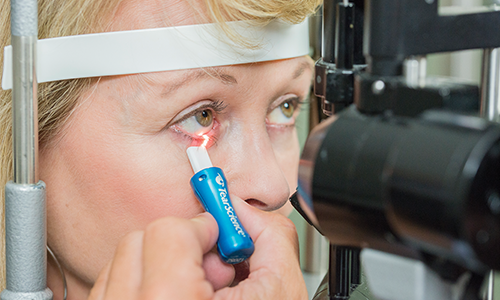Converting Patients to MGD Treatment
By Sara Frye, OD, MPH, FAAO May 26, 2021
We are continually making discoveries when it comes to the ubiquitous condition that is dry eye. One thing we’ve learned is the significant role that meibomian gland dysfunction (MGD) plays in its pathophysiology. This has led to the advent of several therapeutic tools to treat MGD, namely thermal pulsation and intense pulsed light (IPL).
Thermal pulsation is the mainstay of in-office MGD treatments, with Lipiflow (Johnson & Johnson) being the pioneer in this realm. Since then, other devices have come to market, such as iLux (Alcon), MiBo Thermoflo (MiBo Medical) and TearCare (Sight Sciences).
 IPL is an alternative to thermal pulsation and also a very effective treatment for meibomian gland dysfunction. This technology was initially used in dermatology and eventually expanded into eyecare. Optima IPL (Lumenis) has been on the market for years, and was most recently FDA-approved for the treatment of dry eye.
IPL is an alternative to thermal pulsation and also a very effective treatment for meibomian gland dysfunction. This technology was initially used in dermatology and eventually expanded into eyecare. Optima IPL (Lumenis) has been on the market for years, and was most recently FDA-approved for the treatment of dry eye.
Microblepharoexfoliation has also been used as an adjunct treatment for MGD, but Blephex (Alcon) is not a substitute for thermal pulsation or intense pulsed light.
Although these tools enable doctors to treat MGD, they are not covered by insurance. When recommending these procedures, doctors are often met with hesitancy. It’s important to realize that this is normal. This initial reluctance doesn’t mean that patients won’t eventually decide to undergo in-office procedures for the treatment of their dry eye.
Introduce the Technology Early
When patients come to us for dry eye, they may expect that the treatments we propose are the same ones they’ve always been offered: artificial tears and warm compresses. When we launch into our recommendations for in-office procedures, they may not be quite ready to absorb all of this new information. Introducing these technologies before a patient sees you can help them open up to the idea ahead of time. Your practice website is a great place to start, as patients often initially look for their information online. Introduce these technologies on your webpage, with links to manufacturers’ websites for more detail. This will enable patients to do some reading prior to seeing you, so they’ll know what questions to ask when they do.
Make Sure Your Staff Is on Your Team
When patients arrive at your office and move through the work-up, staff can start discussing dry eye treatment technology. Patients often feel comfortable asking staff questions about their experience with the procedure. This allows staff to potentially ease patient fears and hesitations through reassurance. Following your recommendation, it’s also important that staff be able to reiterate the benefits of the procedure(s), and answer any other lingering questions.
If your staff doesn’t feel comfortable with the technology, they will not be proactive in discussing these technologies. Most manufacturers are willing to offer staff training, which can be reinforced with your own guidance.
Use A Variety of Media
Like a student, every patient absorbs information differently. Some appreciate written material, such as a brochure. Others prefer pictures, and their meibography images will be worth a thousand words. Still, others may just need a thorough explanation from the doctor or staff. In the era of COVID-19, we’ve learned that much of our in-person interaction can be substituted with video. In some cases, digital media is preferred, as patients can pause or rewind as needed. Having all of these modes of illustration available for patients will ensure you meet them where they need you.
Schedule A Follow-up Visit
 When a dry eye procedure is first recommended, some patients will jump at the opportunity. This will be especially true for those who have already done their research and feel confident that this is the route they want to take. Other patients will need some time to mull it over. Perhaps they want to talk to their spouse, read the pamphlet or peruse the manufacturer’s website. Give patients the time they need to feel comfortable with their decision. However, make sure you schedule them back for a follow-up to pick up the conversation where it left off. This will help to keep patients engaged in the treatment process. If they express frustration with their at-home regimen at the next visit, use this as an invitation to remind them of the procedures that are available.
When a dry eye procedure is first recommended, some patients will jump at the opportunity. This will be especially true for those who have already done their research and feel confident that this is the route they want to take. Other patients will need some time to mull it over. Perhaps they want to talk to their spouse, read the pamphlet or peruse the manufacturer’s website. Give patients the time they need to feel comfortable with their decision. However, make sure you schedule them back for a follow-up to pick up the conversation where it left off. This will help to keep patients engaged in the treatment process. If they express frustration with their at-home regimen at the next visit, use this as an invitation to remind them of the procedures that are available.
Don’t Take it Personally
We all take pride in the work we do. When we’ve done a thorough dry eye evaluation and extensive counseling on the benefits of treatment, we may feel hurt when the patient isn’t open to taking the recommended course of action. Take the emotion out of it, and use the resources you have to continue educating the patient. Take the opportunity to re-evaluate your office protocol to determine if you’re doing everything you can; if you are, then let it go.
Just because a patient initially declines in-office dry eye treatment, doesn’t mean they will never be open to it. Give patients the tools they need to make the decision comfortably and confidently, and ultimately you will help more people than you initially thought was possible.